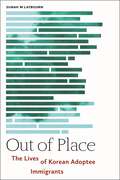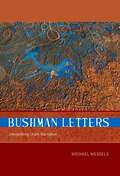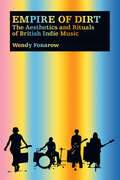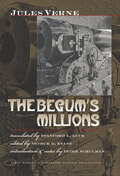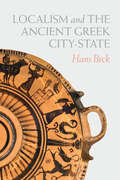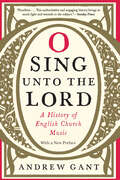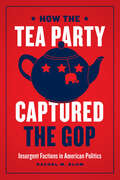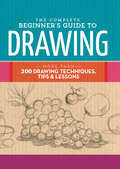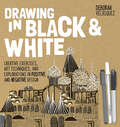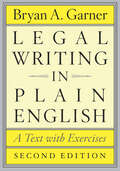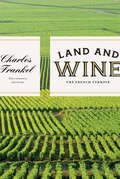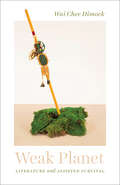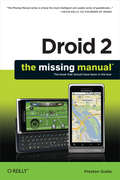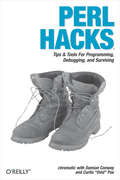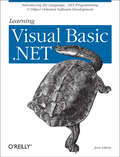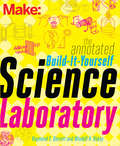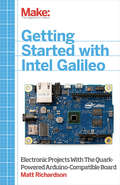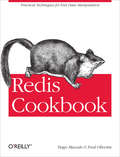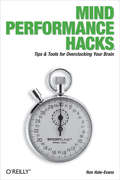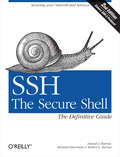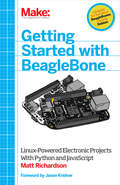- Table View
- List View
Out of Place: The Lives of Korean Adoptee Immigrants (Asian American Sociology #3)
by SunAh M LaybournHow Korean adoptees went from being adoptable orphans to deportable immigrantsSince the early 1950s, over 125,000 Korean children have been adopted in the United States, primarily by white families. Korean adoptees figure in twenty-five percent of US transnational adoptions and are the largest group of transracial adoptees currently in adulthood. Despite being legally adopted, Korean adoptees' position as family members did not automatically ensure legal, cultural, or social citizenship. Korean adoptees routinely experience refusals of belonging, whether by state agents, laws, and regulations, in everyday interactions, or even through media portrayals that render them invisible. In Out of Place, SunAh M Laybourn, herself a Korean American adoptee, examines this long-term journey, with a particular focus on the race-making process and the contradictions inherent to the model minority myth.Drawing on in-depth interviews with Korean adoptee adults, online surveys, and participant observation at Korean adoptee events across the US and in Korea, Out of Place illustrates how Korean adoptees come to understand their racial positions, reconcile competing expectations of citizenship and racial and ethnic group membership, and actively work to redefine belonging both individually and collectively. In considering when and how Korean adoptees have been remade, rejected, and celebrated as exceptional citizens, Out of Place brings to the fore the features of the race-making process.
Bushman Letters: Interpreting |Xam Narrative
by Michael WesselsThe Bleek and Lloyd Collection consists of the notebooks in which William Bleek and Lucy Lloyd transcribed and translated the narratives, cultural information and personal histories told to them in the 1870s by a number of /Xam informants. It represents a rare and rich record of an indigenous language and culture that no longer exists, and has exerted a fascination for anthropologists and poets alike. Yet how does one begin reading texts that are at once so compromised and so unique? Bushman Letters is an important book for it examines not only the /Xam archive, but also the critical tradition that has grown up around it and the hermeneutic principles that inform that tradition. Wessels critiques these principles and offers alternative modes of reading. He shows the problems with the approaches employed by previous critics and, in the course of his own detailed and poetic readings of a number of narratives, suggests what their interpretations have left out. The book must be described as metacritical: it is criticism about the critical tradition that has grown up around the /Xam archive and in the fields of folklore and mythology more widely. Bushman Letters addresses a curiously neglected area in the burgeoning literature on the Bleek and Lloyd Collection: the texts themselves. In doing so, the book makes a substantial contribution to the study of oral narratives in general and to the theoretical discourse that informs such studies.
The Unresolved National Question in South Africa: Left thought under apartheid and beyond
by Edward Webster & Karin PampallisThis volume examines the way in which various strands of left thought have addressed the National Question. The re-emergence of debates on the decolonisation of knowledge has revived interest in the National Question, which began over a century ago and remains unresolved. Tensions that were suppressed and hidden in the past are now being openly debated. Despite this, the goal of one united nation living prosperously under a constitutional democracy remains elusive. This edited volume examines the way in which various strands of left thought have addressed the National Question, especially during the apartheid years, and goes on to discuss its relevance for South Africa today and in the future. Instead of imposing a particular understanding of the National Question, the editors identified a number of political traditions and allowed contributors the freedom to define the question as they believed appropriate - in other words, to explain what they thought was the Unresolved National Question. This has resulted in a rich tapestry of interweaving perceptions. The volume is structured in two parts. The first examines four foundational traditions: Marxism-Leninism (the Colonialism of a Special Type thesis); the Congress tradition; the Trotskyist tradition; and Africanism. The second part explores the various shifts in the debate from the 1960s onwards, and includes chapters on Afrikaner nationalism, ethnic issues, black consciousness, feminism, workerism and constitutionalism. The editors hope that by revisiting the debates not popularly known among the scholarly mainstream, this volume will become a catalyst for an enriched debate on our identity and our future.
Labour Disrupted: Reflections on the future of work in South Africa
by Malehoko Tshoaedi Christine Bischoff Andries Bezuidenhout Janet Cherry Nomkhosi Xulu-Gama Mondli Hlatshwayo Aisha Lorgat Babalwa Magoqwana John Mashayamombe Mpho Mmadi Siphelo Ngcwangu Sandla Nomvete Jantjie Xaba Lucien van Walt Edward WebsterAnalyses the fragmentation and future of labour movements in South Africa and globally in the context of globalisation, the fourth industrial revolution and the Covid-19 pandemic.
Skyscraper Settlement: The Many Lives of Christodora House
by Joyce MilambilingThe roles that Christodora House has played from 19th-century settlement house to its newest formsSettlement house workers helped transform the lives of thousands of people despite lack of funding, the influenza epidemic of 1918, economic depressions, and two World Wars. Many of these houses still exist in the original neighborhoods where they confront the problems of today and advocate for their communities.Christodora House, founded in 1897 as “The Young Women’s Settlement,” played an important role in the life of immigrants and other residents on the Lower East Side of Manhattan. For over 50 years, residents and volunteers at Christodora House provided classes, clubs, recreational activities, and medical and dental clinics for thousands of New Yorkers, and then continued to operate programs out of public housing and other locations for more than two decades.The building at 143 Avenue B, now housing condominiums, has had a tumultuous history since 1948 but still stands, towering over its tenement neighborhood in the East Village. Christodora Inc. is now a nonprofit foundation with offices in Midtown Manhattan, whose staff works with underserved New Yorkers, including youth in the public school system, carrying on a long, distinguished history of service to the city and country.
Empire of Dirt: The Aesthetics and Rituals of British Indie Music (Music Culture)
by Wendy FonarowInside the culture of an artistically influential music community Britain is widely considered the cradle of independent music culture. Bands like Radiohead and Belle and Sebastian, which epitomize indie music's sounds and attitudes, have spawned worldwide fanbases. This in-depth study of the British independent music scene explores how the behavior of fans, artists, and music industry professionals produce a community with a specific aesthetic based on moral values. Author Wendy Fonarow, a scholar with years of experience in the various sectors of the indie music scene, examines the indie music "gig" as a ritual in which all participants are actively involved. This ritual allows participants to play with cultural norms regarding appropriate behavior, especially in the domains of sex and creativity. Her investigation uncovers the motivations of audience members when they first enter the community and how their positions change over time so that the gig functions for most members as a rite of passage. Empire of Dirt sheds new light on music, gender roles, emotion, subjectivity, embodiment, and authenticity.
The Begum's Millions: Extraordinary Voyages #18 (Early Classics of Science Fiction)
by Jules VerneVerne's first cautionary tale about the dangers of science — first modern and corrected English translation. When two European scientists unexpectedly inherit an Indian rajah's fortune, each builds an experimental city of his dreams in the wilds of the American Northwest. France-Ville is a harmonious urban community devoted to health and hygiene, the specialty of its French founder, Dr. François Sarrasin. Stahlstadt, or City of Steel, is a fortress-like factory town devoted to the manufacture of high-tech weapons of war. Its German creator, the fanatically pro-Aryan Herr Schultze, is Verne's first truly evil scientist. In his quest for world domination and racial supremacy, Schultze decides to showcase his deadly wares by destroying France-Ville and all its inhabitants. Both prescient and cautionary, The Begum's Millions is a masterpiece of scientific and political speculation and constitutes one of the earliest technological utopia/dystopias in Western literature. This Wesleyan edition features notes, appendices, and a critical introduction as well as all the illustrations from the original French edition.
Localism and the Ancient Greek City-State
by Hans BeckA Greek historian investigates the importance of local identity in the Mediterranean world in a “rare, genuinely original book . . . Highly recommended” (Choice).Much as our modern world is interconnected through global networks, the ancient Greek city-states were a dynamic part of the wider Mediterranean landscape. In Localism and the Ancient Greek World, historian Hans Beck argues that local shifts in politics, religion and culture had a pervasive influence in a world of fast-paced change.Citizens in these communities were deeply concerned with maintaining local identity, commercial freedom, distinct religious cults, and much more. Beyond these cultural identifiers, there lay a deeper concept of the local that guided polis societies in their contact with a rapidly expanding world.Drawing on a staggering range of materials—including texts by both known and obscure writers, numismatics, pottery analysis, and archeological records—Beck develops fine-grained case studies that illustrate the significance of the local experience. Localism and the Ancient Greek City-State builds bridges across disciplines and ideas within the humanities. It highlights the importance of localism not only in the archaeology of the ancient Mediterranean, but also in today’s conversations about globalism, networks, and migration.
O Sing unto the Lord: A History of English Church Music
by Andrew GantThis history of English church music is “one of the wittiest and most whimsically irreverent works of scholarship in recent memory” (The Christian Century).For as long as people have worshipped together, music has played a key role in church life. Here, Andrew Gant offers a fascinating history of English church music, from the Latin chant of late antiquity to the great proliferation of styles seen in contemporary repertoires.The ornate complexity of pre-Reformation Catholic liturgies revealed the exclusive nature of this form of worship. By contrast, simple English psalms, set to well-known folk songs, summed up the aims of the Reformation with its music for everyone. The Enlightenment brought hymns, the Methodists and Victorians a new delight in the beauty and emotion of worship. Today, church music mirrors our multifaceted worldview, embracing the sounds of pop and jazz along with the more traditional music of choir and organ. And reflecting its truly global reach, the influence of English church music can be found in everything from masses sung in Korean to American Sacred Harp singing.From medieval chorales to “Amazing Grace,” West Gallery music to Christmas carols, English church music has broken through the boundaries of time, place, and denomination to remain familiar and cherished everywhere. O Sing unto the Lord is the biography of a tradition, a book that “celebrates the sheer pleasure of raising a joyful sound to the Lord” (The Guardian).“What, fundamentally, is the function of church music, and why have clerical authorities often been suspicious of how much attention music receives? Gant engages these questions in intelligent, energetic prose.” —Publishers Weekly“Excellent . . . this authoritative and engaging history brings so much light and warmth to the subject.” —Sunday Times“The beauty of relating Christian history this way is that it broadens the focus to include the listening laity, not just the clergy or the church establishment.” —Foreword Reviews
How the Tea Party Captured the GOP: Insurgent Factions in American Politics
by Rachel M. BlumThis incisive and timely study of American party politics reveals how a fringe group within the Republican party came to wield outsized power.The rise of the Tea Party redefined both the Republican Party and how we think about intraparty conflict. What initially appeared to be an anti-Obama protest movement of fiscal conservatives matured into a faction that sought to increase its influence in the Republican Party by any means necessary. Tea Partiers captured the party’s organizational machinery and used it to replace established politicians with Tea Party–style Republicans, eventually laying the groundwork for the nomination and election of a candidate like Donald Trump.In How the Tea Party Captured the GOP, Rachel Marie Blum offers a novel theory of political party factions, framing them as miniature parties within parties. Using this framework, she demonstrates how fringe groups can leverage factions to increase their political influence in the American two-party system. In this richly researched book, Blum uncovers how the electoral losses of 2008 sparked disgruntled Republicans to form the Tea Party faction, and the strategies the Tea Party used to wage a systematic takeover of the Republican Party. This book not only illuminates how the Tea Party achieved its influence, but also provides a blueprint for identifying other factional insurgencies.
The Complete Beginner's Guide to Drawing: More Than 200 Drawing Techniques, Tips & Lessons
by Walter Foster Creative TeamPractice drawing a variety of subjects and build or hone your artistic skills with this helpful guide featuring over two hundred drawing techniques, tips and tricks.This comprehensive drawing guide covers a vast array of subjects, from landscapes, still lifes, and flowers to animals, portraits, and the human figure. Begin with a thorough introduction to the essential tools and materials you need to get started, including different types of pencils, sketchbooks, papers, and other tools. Then learn the fundamentals of drawing, as well as a variety of drawing techniques, including rendering realistic textures, creating volume, and capturing perspective. A series of easy-to-follow, step-by-step projects cover a variety of techniques, including:Developing formRendering textureDepth and distanceForeshorteningValues and shadingPerspectiveBalance and compositionCapturing realism and likenessDepicting figures in actionWith helpful tips and straightforward step-by-step lessons, The Complete Beginner’s Guide to Drawing is the perfect resource for beginning artists who want to improve their drawing skills.
Drawing in Black & White: Creative Exercises, Art Techniques, and Explorations in Positive and Negative Design
by Deborah Velasquez&“The style of this book is loose and easy, about having fun, and learning to work within the confines of black and white rather than depending on color.&” —Art Elements Working with only positive and negative lines and shapes keeps the focus on the basics: composition, balance, and harmony. And using white and black gel, ink, and paint pens on black, tan, and gray papers allows you to experience drawing in a whole new way! Drawing in Black & White is a clever drawing and design book that contains 36 inspiring exercises and a gallery of artwork. Follow the tips and draw on black, gray, and tan paper to learn how different colored papers can make simple images pop. You&’ll find lessons on drawing, pattern drawing, drawing with cut paper, and simple collage. Learn to see your drawings a new way by drawing in black and white! &“While confined to only two colors, black and white, this guide&’s techniques, materials, and tools are not nearly so limited . . . Readers with some experience drawing and painting are the best audience for this guide, but there is plenty here for beginners and advanced artists, too.&” —Library Journal &“The goal of the book is to let you be familiar with black and white media, to draw and have fun . . . It&’s a fun activity book for those who want to dabble with art.&” —Parka Blogs
Legal Writing in Plain English: A Text with Exercises (Chicago Guides to Writing, Editing, and Publishing)
by Bryan A. Garner“This easy-to-follow guide is useful both as a general course of instruction and as a targeted aid in solving particular legal writing problems.” —Harvard Law ReviewClear, concise, down-to-earth, and powerful—all too often, legal writing embodies none of these qualities. Its reputation for obscurity and needless legalese is widespread. For more than twenty years, Bryan A. Garner’s Legal Writing in Plain English has helped address this problem by providing lawyers, judges, paralegals, law students, and legal scholars with sound advice and practical tools for improving their written work. The leading guide to clear writing in the field, this indispensable volume encourages legal writers to challenge conventions and offers valuable insights into the writing process that will appeal to other professionals: how to organize ideas, create and refine prose, and improve editing skills.Accessible and witty, Legal Writing in Plain English draws on real-life writing samples that Garner has gathered through decades of teaching. Trenchant advice covers all types of legal materials, from analytical and persuasive writing to legal drafting, and the book’s principles are reinforced by sets of basic, intermediate, and advanced exercises in each section.In this new edition, Garner preserves the successful structure of the original while adjusting the content to make it even more classroom-friendly. He includes case examples from the past decade and addresses the widespread use of legal documents in electronic formats. His book remains the standard guide for producing the jargon-free language that clients demand and courts reward.“Those who are willing to approach the book systematically and to complete the exercises will see dramatic improvements in their writing.” —Law Library Journal
Land and Wine: The French Terroir
by Charles FrankelThis in-depth tour of the French winemaking regions illustrates how the soil, underlying bedrock, and microclimate shape the personality of a wine.France has long been the world’s greatest wine-producing country. Its various regions each offer unique tasting experiences, from the spice of Bordeaux to the berry notes of the Loire Valley. In Land and Wine, geologist Charles Frankel guides readers through these and ten other regions, including Alsace, Burgundy, Champagne, Provence, and the Rhône valley, to explore the full meaning of terroir.Frankel describes how Cabernet Franc takes on a completely different character depending on whether it is grown on gravel or limestone; how Sauvignon yields three different products in the hills of Sancerre; how Pinot Noir will give radically different wines on a single hill in Burgundy as the vines progress upslope; and how the soil of each château in Bordeaux has a say in the blend ratios of Merlot and Cabernet-Sauvignon.Land and Wine provides a detailed understanding of the variety of French wine as well as a look at the geological history of France, complete with volcanic eruptions, dinosaurs, and a menagerie of fossils flavoring the vineyards. Frankel also blends in anecdotes about winemakers and historic wine enthusiasts while offering travel tips and itineraries for visiting the wineries today.
Weak Planet: Literature and Assisted Survival
by Wai Chee Dimock“Exploring weakness and vulnerability from the origins of American literature to the present, she provocatively argues for ‘collateral resilience.’” —Viet Thanh Nguyen, Pulitzer Prize–winning authorVulnerability. We see it everywhere. In once permanent institutions. In runaway pandemics. In democracy itself. And most frighteningly, in ecosystems with no sustainable future. Against these large-scale hazards of climate change, what can literature teach us? This is the question Wai Chee Dimock asks in Weak Planet, proposing a way forward, inspired by works that survive through kinship with strangers and with the nonhuman world.Drawing on Native American studies, disability studies, and environmental humanities, Dimock shows how hope can be found not in heroic statements but in incremental and unspectacular teamwork. Reversing the usual focus on hegemonic institutions, she highlights instead incomplete gestures given an afterlife with the help of others. She looks at Louise Erdrich’s and Sherman Alexie’s user-amended captivity narratives; nontragic sequels to Moby-Dick by C. L. R. James, Frank Stella, and Amitav Ghosh; induced forms of Irishness in Henry James, Colm Tóibín, W. B. Yeats, and Gish Jen; and the experimentations afforded by a blurry Islam in works by Henri Matisse, James Joyce, Ezra Pound, and Langston Hughes. Celebrating literature’s durability as an assisted outcome, Weak Planet gives us new ways to think about our collective future.“Weak Planet invites us to reflect on the deep interconnections between two threatened extinctions: that of the humanities and that of a host of animal species (not least our own). The book is nothing short of a radical reorientation of literary history.” —Stephen Best, author of None Like Us: Blackness, Belonging, Aesthetic Life
Droid 2: The Missing Manual
by Preston GrallaReady to unleash the Droid 2? This entertaining guide helps you take full command of Motorola’s sleek new device to get online, shop, find locations, keep in touch, and much more. Every page is packed with useful information you can put to work right away, from setup to troubleshooting, with lots of valuable tips and tricks along the way.Get organized. Sync your contacts, calendar, and email with your Google Calendar and Outlook accounts.Go online. Make your phone a portable hotspot or a modem to get your laptop online.Be productive. Use Google docs to create and edit documents, spreadsheets, and presentations.Play music. Purchase music from Amazon and sync your Droid 2 with Windows Media Player.Capture photos and video. Edit your photos and share everything you shoot—instantly.
Perl Hacks: Tips & Tools for Programming, Debugging, and Surviving
by Damian Conway Curtis Ovid" Poe Curtis Ovid Poe ChromaticWith more than a million dedicated programmers, Perl has proven to be the best computing language for the latest trends in computing and business. While other languages have stagnated, Perl remains fresh, thanks to its community-based development model, which encourages the sharing of information among users. This tradition of knowledge-sharing allows developers to find answers to almost any Perl question they can dream up. And you can find many of those answers right here in Perl Hacks. Like all books in O'Reilly's Hacks Series, Perl Hacks appeals to a variety of programmers, whether you're an experienced developer or a dabbler who simply enjoys exploring technology. Each hack is a short lesson--some are practical exercises that teach you essential skills, while others merely illustrate some of the fun things that Perl can do. Most hacks have two parts: a direct answer to the immediate problem you need to solve right now and a deeper, subtler technique that you can adapt to other situations. Learn how to add CPAN shortcuts to the Firefox web browser, read files backwards, write graphical games in Perl, and much more.For your convenience, Perl Hacks is divided by topic--not according toany sense of relative difficulty--so you can skip around and stop at any hack you like. Chapters include:Productivity HacksUser InteractionData MungingWorking with ModulesObject HacksDebuggingWhether you're a newcomer or an expert, you'll find great value in Perl Hacks, the only Perl guide that offers somethinguseful and fun for everyone.
Learning Visual Basic .NET: Introducing the Language, .NET Programming & Object Oriented Software Development
by Jesse LibertyMost Visual Basic .NET books are written for experienced object-oriented programmers, but many programmers jumping on the .NET bandwagon are coming from non-object-oriented languages, such as Visual Basic 6.0 or from script programming, such as JavaScript. These programmers, and those who are adopting VB.NET as their first programming language, have been out of luck when it comes to finding a high-quality introduction to the language that helps them get started.That's why Jesse Liberty, author of the best-selling books Programming C# and Programming ASP.NET, has written an entry-level guide to Visual Basic .NET. Written in a warm and friendly manner, this book assumes no prior programming experience, and provides an easy introduction to Microsoft's most popular .NET language.Learning Visual Basic .NET is a complete introduction to VB.NET and object-oriented programming. This book will help you build a solid foundation in .NET, and show how to apply your skills by using hundreds of examples to help you become productive quickly. Learning Visual Basic .NET introduces fundamentals like Visual Studio .NET, a tool set for building Windows and Web applications. You'll learn about the syntax and structure of the Visual Basic .NET language, including operators, classes and interfaces, structs, arrays, and strings. Liberty then demonstrates how to develop various kinds of applications--including those that work with databases--and web services.By the time you've finished Learning Visual Basic .NET, you'll be ready to move on to a more advanced programming guide that will help you create large-scale web and Windows applications.Whether you have a little object-oriented programming experience or you are new to programming altogether, Visual Basic .NET will set you firmly on your way to mastering the essentials of the VB.NET language.
The Annotated Build-It-Yourself Science Laboratory: Build Over 200 Pieces of Science Equipment!
by Raymond Barrett Windell OskayRaymond E. Barrett's Build-It-Yourself Science Laboratory is a classic book that took on an audacious task: to show young readers in the 1960s how to build a complete working science lab for chemistry, biology, and physics--and how to perform experiments with those tools. The experiments in this book are fearless and bold by today's standards--any number of the experiments might never be mentioned in a modern book for young readers! Yet, many from previous generations fondly remember how we as a society used to embrace scientific learning. This new version of Barrett's book has been updated for today's world with annotations and updates from Windell Oskay of Evil Mad Scientist Laboratories, including extensive notes about modern safety practices, suggestions on where to find the parts you need, and tips for building upon Barrett's ideas with modern technology. With this book, you'll be ready to take on your own scientific explorations at school, work, or home.
Getting Started with Intel Galileo: Electronic Projects with the Quark-Powered Arduino-Compatible Board
by Matt RichardsonGetting Started with the Intel Galileo gets you up and running with this new, x86-powered board that was developed in collaboration between Arduino and Intel. You'll learn how to set it up, connect it to your computer, and begin programming. You'll learn how to build electronics projects around the Galileo, and you'll explore the features and power that make it different from all the boards that came before.Developed in collaboration with the Intel Galileo team, and in consultation with members of the Arduino team, this is the definitive introduction to Intel's new board for makers.
Mastering Perl/Tk: Graphical User Interfaces in Perl
by Stephen Lidie Nancy WalshPerl/Tk is the marriage of the Tk graphical toolkit with Perl, the powerful programming language used primarily for system administration, web programming, and database manipulation. With Perl/Tk, you can build Perl programs with an attractive, intuitive GUI interface with all the power of Perl behind it.Mastering Perl/Tk is the "bible" of Perl/Tk: It's not only a great book for getting started, but the best reference for learning the techniques of experienced Perl/Tk programmers. The first half of the book contains the basics on how to use Perl/Tk, and then branches out into advanced applications with a series of extensive program examples. The result is a book accessible for novices, and invaluable for experienced programmers ready to learn the next step in the elegant and effective use of Perl/Tk. The book includes:An introduction to each of the basic Perl/Tk widgets and geometry managersA dissection of the MainLoop, including how to use callbacks and bindings effectivelyCoverage of the Tix widgets, an extended set of widgets that are a part of the standard Perl/Tk distributionWorking with images in Perl/Tk, including bitmaps, pixmaps, photos, and how to compose a compound image typeHow to create custom mega-widgets in Perl/Tk, both composite and derivedHandling interprocess communication with Perl/Tk, both with standard Unix utilities (pipes and sockets) and with the send command designed for direct communication between Tk applicationsDeveloping your own Tk widget in the C languageExamples of web applications written with Perl/Tk and the LWP libraryThe book also includes appendices on installing Perl/Tk, a complete quick-reference for each standard widget, and listings of all the extended examples in the book.Nancy Walsh is the author of Learning Perl/Tk, and Steve Lidie wrote the Perl/Tk Pocket Reference as well as a series of Perl/Tk articles in The Perl Journal. Together, they have written Mastering Perl/Tk to be the definitive guide to Perl/Tk.
Redis Cookbook: Practical Techniques for Fast Data Manipulation
by Tiago Macedo Fred OliveiraTwo years since its initial release, Redis already has an impressive list of adopters, including Engine Yard, GitHub, Craigslist, and Digg. This open source data structure server is built for speed and flexibility, making it ideal for many applications. If you're using Redis, or considering it, this concise cookbook provides recipes for a variety of issues you're likely to face.Each recipe solves a specific problem, and provides an in-depth discussion of how the solution works. You’ll discover that Redis, while simple in nature, offers extensive functionality for manipulating and storing data.Learn when it makes sense to use RedisExplore several methods for installing RedisConnect to Redis in a number of ways, ranging from the command line to popular languages such as Python and RubySolve a range of needs, from linked datasets to analyticsHandle backups, sharding, datasets larger than available memory, and many other tasks
Mind Performance Hacks: Tips & Tools for Overclocking Your Brain
by Ron Hale-EvansYou're smart. This book can make you smarter.Mind Performance Hacks provides real-life tips and tools for overclocking your brain and becoming a better thinker. In the increasingly frenetic pace of today's information economy, managing your life requires hacking your brain. With this book, you'll cut through the clutter and tune up your brain intentionally, safely, and productively.Grounded in current research and theory, but offering practical solutions you can apply immediately, Mind Performance Hacks is filled with life hacks that teach you to:Use mnemonic tricks to remember numbers, names, dates, and other flotsam you need to recallPut down your calculator and perform complex math in your head, with your fingers, or on the back of a napkinSpark your creativity with innovative brainstorming methodsUse effective systems to capture new ideas before they get awayCommunicate in creative new ways-even using artificial languagesMake better decisions by foreseeing problems and finding surprising solutionsImprove your mental fitness with cool tricks and gamesWhile the hugely successful Mind Hacks showed you how your brain works, Mind Performance Hacks shows you how to make it work better.
SSH, The Secure Shell: The Definitive Guide
by Daniel J. Barrett Robert G. Byrnes Richard E. SilvermanAre you serious about network security? Then check out SSH, the Secure Shell, which provides key-based authentication and transparent encryption for your network connections. It's reliable, robust, and reasonably easy to use, and both free and commercial implementations are widely available for most operating systems. While it doesn't solve every privacy and security problem, SSH eliminates several of them very effectively.Everything you want to know about SSH is in our second edition of SSH, The Secure Shell: The Definitive Guide. This updated book thoroughly covers the latest SSH-2 protocol for system administrators and end users interested in using this increasingly popular TCP/IP-based solution.How does it work? Whenever data is sent to the network, SSH automatically encrypts it. When data reaches its intended recipient, SSH decrypts it. The result is "transparent" encryption-users can work normally, unaware that their communications are already encrypted. SSH supports secure file transfer between computers, secure remote logins, and a unique "tunneling" capability that adds encryption to otherwise insecure network applications. With SSH, users can freely navigate the Internet, and system administrators can secure their networks or perform remote administration.Written for a wide, technical audience, SSH, The Secure Shell: The Definitive Guide covers several implementations of SSH for different operating systems and computing environments. Whether you're an individual running Linux machines at home, a corporate network administrator with thousands of users, or a PC/Mac owner who just wants a secure way to telnet or transfer files between machines, our indispensable guide has you covered. It starts with simple installation and use of SSH, and works its way to in-depth case studies on large, sensitive computer networks.No matter where or how you're shipping information, SSH, The Secure Shell: The Definitive Guide will show you how to do it securely.
Getting Started with BeagleBone: Linux-Powered Electronic Projects With Python and JavaScript
by Matt RichardsonMany people think of Linux as a computer operating system, running on users' desktops and powering servers. But Linux can also be found inside many consumer electronics devices. Whether they're the brains of a cell phone, cable box, or exercise bike, embedded Linux systems blur the distinction between computer and device. Many makers love microcontroller platforms such as Arduino, but as the complexity increases in their projects, they need more power for applications, such as computer vision. The BeagleBone is an embedded Linux board for makers. It's got built-in networking, many inputs and outputs, and a fast processor to handle demanding tasks. This book introduces you to both the original BeagleBone and the new BeagleBone Black and gets you started with projects that take advantage of the board's processing power and its ability to interface with the outside world.
